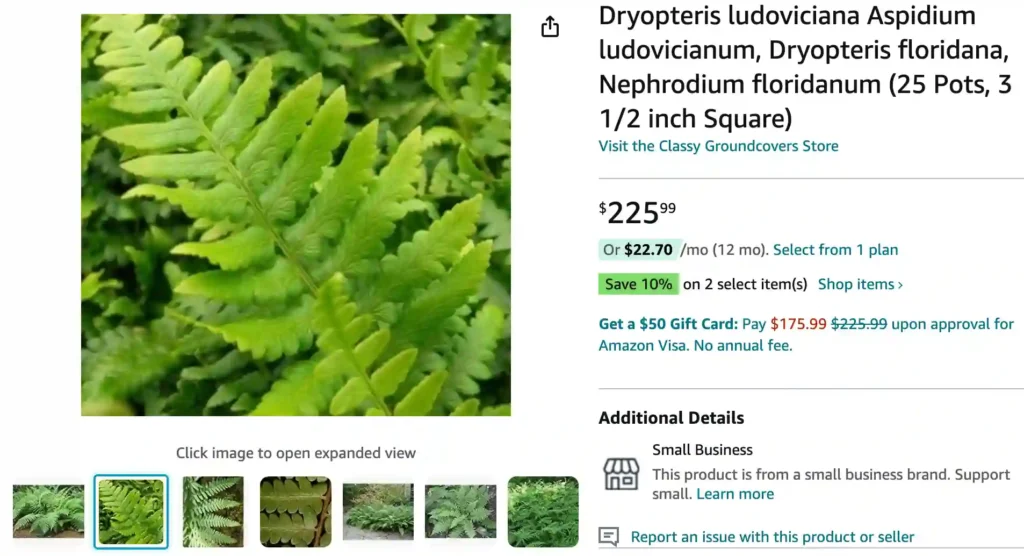
All About Dryopteris Ludoviciana: The Southern Wood Fern That Thrives in the Shade
I’m Ferb Vu, and I’m a plant enthusiast with a particular fondness for ferns. Today, I want to delve into the world of Dryopteris Ludoviciana, also known as the Southern Wood Fern. This statuesque fern is a native of the southeastern United States, bringing a touch of elegance and lushness to shady gardens.
What Makes Dryopteris Ludoviciana Special?
Stately and Evergreen (in Warm Climates): Unlike many ferns that die back in winter, Dryopteris Ludoviciana retains its fronds in mild climates, providing year-round greenery. Its upright, glossy green fronds can reach up to 3 feet tall, creating a stunning architectural presence in the shade.
Adaptable to Moisture: This fern is a bit of a chameleon. While native to swamps, it tolerates drier conditions once established. In hot, humid regions, it thrives in consistently moist soil.
Low-Maintenance Beauty: This slow to moderate grower requires minimal fuss. Once planted in the right spot, it doesn’t demand constant attention.
Perfect for Shady Spots: Struggling to find plants that thrive in the shade? Dryopteris Ludoviciana thrives in part shade to full shade, making it ideal for areas that receive little direct sunlight.
How to care for Dryopteris Ludoviciana?
Choosing the Right Spot: Select a location with dappled sunlight or afternoon shade. Avoid harsh, direct sun, which can scorch the fronds.
Soil Preparation: Ferns prefer rich, well-draining, and slightly acidic soil. If your soil is heavy clay, amend it with compost or organic matter to improve drainage.
Planting: Dig a hole slightly larger than the root ball and plant the fern at the same depth it was growing in the container. Water thoroughly after planting.
Watering: Keep the soil consistently moist, especially during the first growing season. Water deeply at the base of the plant, allowing excess water to drain. As the fern matures, it becomes more tolerant of drier conditions.
Fertilizing: Apply a balanced fertilizer formulated for ferns once a month during the growing season (spring and summer). Alternatively, you can topdress the soil with a layer of compost in early spring.
Is Dryopteris Ludoviciana deer resistant?
Yes! Deer tend to leave this fern alone, making it a great choice for gardens frequented by these herbivores.
Does Dryopteris Ludoviciana spread?
This fern spreads slowly by underground rhizomes, forming a clump that expands gradually. It’s not invasive and won’t take over your garden.
How can I propagate Dryopteris Ludoviciana?
There are two main methods: division and spores. Division is best done in spring. Spores are trickier and require specific conditions to germinate.
What are some good companion plants for Dryopteris Ludoviciana?
Hostas, coral bells, heuchera, and other shade-loving perennials create a harmonious combination.
Dryopteris Ludoviciana vs. Other Ferns
Dryopteris Marginalis (Leatherwood Fern): Both ferns share similar characteristics like upright growth and tolerance for shade. However, Dryopteris Marginalis features silvery undersides to its fronds, while Dryopteris Ludoviciana boasts glossy green all around.
Athyrium Filix-Femina (Lady Fern): This fern has a more delicate appearance with graceful, arching fronds. While both prefer shade, Lady Fern might need slightly more moisture than Dryopteris Ludoviciana.
Osmunda Regalis (Royal Fern): A showstopper for large gardens, Royal Fern boasts immense fronds that can reach up to 8 feet tall. Dryopteris Ludoviciana offers a more compact size, making it suitable for smaller spaces.
By following these tips, you can successfully cultivate Dryopteris Ludoviciana and enjoy its lush presence in your garden for years to come. This easy-care fern adds a touch of timeless elegance to shady areas, making it a valuable asset to any shade garden.




